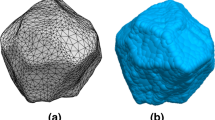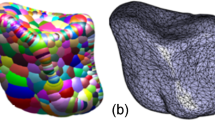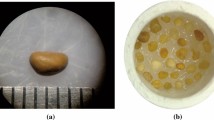Abstract
Physics engines, originally developed to simulate physical and mechanical processes in modern video games, are increasingly used as a scientific computational platform in many disciplines due to their high computational efficiency. This study explores the feasibility of using an open-source physics engine, Project Chrono, to simulate direct shear tests. This study develops a series of pre-processing, servo-controlling, and post-processing functions in Project Chrono to generate soil specimens with designed packing densities, perform direct shear tests, and output simulation results including stress–strain relations, fabrics, and force chains. To determine inter-particle contact forces, typical DEM codes use soft contact models, while most physics engines use hard contact models. The hard contact model enables physics engines to use large time steps in iterations without affecting the numerical stability and simulation accuracy, which remarkably reduces simulation time compared with typical DEM codes. Based on systematical comparisons between simulation results of two contact models, this study demonstrates that the hard contact model can yield the same direct shear test results observed in soft contact model simulations, but is ten times faster than the soft contact model for simulating the same number of particles. This study may provide DEM modelers with the physics engine as one more option for soil behavior simulation.


















Similar content being viewed by others
References
Zheng J, Hryciw RD (2016) A corner preserving algorithm for realistic DEM soil particle generation. Granul Matter 18:84. https://doi.org/10.1007/s10035-016-0679-0
Zheng J, Hryciw RD (2017) An image based clump library for DEM simulations. Granul Matter 19:1–15. https://doi.org/10.1007/s10035-017-0713-x
Jing L, Kwok CY, Leung YF (2017) Micromechanical origin of particle size segregation. Phys Rev Lett 118:1–5. https://doi.org/10.1103/PhysRevLett.118.118001
Taghavi R (2011) Automatic clump generation based on mid-surface. In: Sainsbury B (ed) The 2nd international FLAC/DEM symposium. Itasca International Inc., Minneapolis, Melbourne, Bre-Anne Sainsbury pp 791–797
Kloss C, Goniva C, Hager A et al (2012) Models, algorithms and validation for opensource DEM and CFD-DEM. Prog Comput Fluid Dyn Int J 12:140–152. https://doi.org/10.1504/PCFD.2012.047457
Šmilauer V et al (2015) Yade documentation 2nd ed. The Yade Project. https://doi.org/10.5281/zenodo.34073 (http://yade-dem.org/doc/)
Cundall PA (1971) A computer model for simulating progressive large scale movements in blocky rock systems. In: Symposium on international society on rock mechanics, vol 1, pp 129–136
Cundall PA, Strack ODL (1979) A discrete numerical model for granular assemblies. Géotechnique 29:47–65. https://doi.org/10.1680/geot.1979.29.1.47
Thornton C (1997) Coefficient of restitution for collinear collisions of elastic-perfectly plastic spheres. J Appl Mech 64:383. https://doi.org/10.1115/1.2787319
Galindo-Torres SA, Muñoz JD, Alonso-Marroquín F et al (2015) Frictional contact in collections of rigid or deformable bodies: numerical simulation of geomaterial motions. Phys Rev E 41:347–374. https://doi.org/10.1103/physreve.70.061303
Richefeu V, Radjai F, El Youssoufi MS et al (2006) Stress transmission in wet granular materials. Eur Phys J E 21:1–11. https://doi.org/10.1140/epje/i2006-10077-1
Lee SJ, Hashash YMA (2015) iDEM: an impulse-based discrete element method for fast granular dynamics. Int J Numer Methods Eng 104:79–103. https://doi.org/10.1002/nme
He H, Zheng J (2020) Simulations of realistic granular soils in oedometer tests using physics engine. Int J Numer Anal Methods Geomech 44:983–1002. https://doi.org/10.1002/nag.3031
Erez T, Tassa Y, Todorov E (2015) Simulation tools for model-based robotics: comparison of Bullet, Havok, MuJoCo, ODE and PhysX. In: Proceedings—IEEE international conference on robotics and automation, Seattle, pp 4397–4404
Klaus G, Glette K, Høvin M (2013) Evolving locomotion for a 12-DOF quadruped robot in simulated environments. BioSystems 112:102–106. https://doi.org/10.1016/j.biosystems.2013.03.008
Weiss T, Litteneker A, Jiang C, Terzopoulos D (2019) Position-based real-time simulation of large crowds. Comput Graph 78:12–22. https://doi.org/10.1016/j.cag.2018.10.008
Chui Y-P, Heng P-A (2010) Vaccination as a means of disease prevention. Prog Biophys Mol Biol 103:252–261. https://doi.org/10.1016/j.pbiomolbio.2010.09.003
Ermisoglu E, Sen F, Kockara S et al (2009) Scooping simulation framework for artificial cervical disc replacement surgery. In: Conference proceedings—IEEE international conference on systems, man and cybernetics
Craighead J, Murphy R, Burke J, Goldiez B (2007) A survey of commercial and open source unmanned vehicle simulators. In: Proceedings—IEEE international conference on robotics and automation
Xu J, Tang Z, Yuan X et al (2018) A VR-based the emergency rescue training system of railway accident. Entertain Comput 27:23–31. https://doi.org/10.1016/j.entcom.2018.03.002
Kim KJ, Cho SB (2015) Inference of other’s internal neural models from active observation. BioSystems 128:37–47. https://doi.org/10.1016/j.biosystems.2015.01.005
Lim KW, Krabbenhoft K, Andrade JE (2014) A contact dynamics approach to the granular element method. Comput Methods Appl Mech Eng 268:557–573. https://doi.org/10.1016/j.cma.2013.10.004
Fleischmann J, Serban R, Negrut D, Jayakumar P (2016) On the importance of displacement history in soft-body contact models. J Comput Nonlinear Dyn 11:1–5. https://doi.org/10.1115/1.4031197
Cundall PA (2001) A discontinuous future for numerical modelling in geomechanics? Proc Inst Civ Eng Geotech Eng 149:41–47. https://doi.org/10.1680/geng.2001.149.1.41
Tasora A, Serban R, Mazhar H et al (2016) Chrono: an open source multi-physics dynamics engine. In: Lecture notes in computer science (including subseries Lecture notes in artificial intelligence and lecture notes in bioinformatics)
Tasora A, Silvestri M, Righettini P (2007) Architecture of the Chrono:: engine physics simulation middleware. In: Proceedings of ECCOMAS 2007 multibody conference, pp 25–28
Datar M, Gorsich D, Lamb D, Negrut D (2009) A framework for terrain-induced uncertainty quantification in vehicle dynamics simulation. Int J Veh Syst Model Test 4:234–255. https://doi.org/10.1504/IJVSMT.2009.032018
Recuero A, Serban R, Peterson B et al (2017) A high-fidelity approach for vehicle mobility simulation: nonlinear finite element tires operating on granular material. J Terramech 72:39–54. https://doi.org/10.1016/j.jterra.2017.04.002
Pazouki A, Kwarta M, Williams K et al (2017) Compliant contact versus rigid contact: a comparison in the context of granular dynamics. Phys Rev E 96:1–13. https://doi.org/10.1103/PhysRevE.96.042905
Tracy DJ, Buss SR, Woods BM (2009) Efficient large-scale sweep and prune methods with AABB insertion and removal. In: Proceedings of the IEEE virtual reality conference, pp 191–198
Horabik J, Molenda M (2016) Parameters and contact models for DEM simulations of agricultural granular materials: a review. Biosyst Eng 147:206–225. https://doi.org/10.1016/j.biosystemseng.2016.02.017
Tasora A, Anitescu M (2011) A matrix-free cone complementarity approach for solving large-scale, nonsmooth, rigid body dynamics. Comput Methods Appl Mech Eng 200:439–453. https://doi.org/10.1016/j.cma.2010.06.030
Cui L, O’Sullivan C (2006) Exploring the macro- and micro-scale response of an idealised granular material in the direct shear apparatus. Géotechnique 56:455–468. https://doi.org/10.1680/geot.56.7.455
O’Sullivan C, Bray JD, Riemer M (2004) Examination of the response of regularly packed specimens of spherical particles using physical tests and discrete element simulations. J Eng Mech 130:1140–1150. https://doi.org/10.1061/(ASCE)0733-9399(2004)130:9(1032)
ASTMD3080/D3080M-11 (2011) Standard test method for direct shear test of soils under consolidated drained conditions. ASTM International, West Conshohocken
Fonseca J, O’Sullivan C, Coop MRR, Lee PDD (2013) Quantifying the evolution of soil fabric during shearing using directional parameters. Géotechnique 63:487–499. https://doi.org/10.1680/geot.12.P.003
Fonseca J, O’Sullivan C, Coop MR, Lee PD (2013) Quantifying the evolution of soil fabric during shearing using scalar parameters. Géotechnique 63:818–829. https://doi.org/10.1680/geot.11.P.150
Kanatani K (1984) Distribution of directional data and fabric tensors. Int J Eng Sci 22:149–164
Dafalias YF, Papadimitriou AG, Li XS (2004) Sand plasticity model accounting for inherent fabric anisotropy. J Eng Mech 130:1319–1333. https://doi.org/10.1061/(asce)0733-9399(2004)130:11(1319)
Dafalias YF, Li XS, Dafalias YF (2004) A constitutive framework for anisotropic sand including non-proportional loading. Géotechnique 54:41–55. https://doi.org/10.1680/geot.54.1.41.36329
Gao Z, Zhao J, Yao Y (2010) A generalized anisotropic failure criterion for geomaterials. Int J Solids Struct 47:3166–3185. https://doi.org/10.1016/j.ijsolstr.2010.07.016
Gao Z, Zhao J (2013) Strain localization and fabric evolution in sand. Int J Solids Struct 50:3634–3648. https://doi.org/10.1016/j.ijsolstr.2013.07.005
Zhao J, Gao Z (2016) Unified anisotropic elastoplastic model for sand. J Eng Mech 142:04015056. https://doi.org/10.1061/(ASCE)EM.1943-7889.0000962
Barreto D, O’Sullivan C (2012) The influence of inter-particle friction and the intermediate stress ratio on soil response under generalised stress conditions. Granul Matter 14:505–521. https://doi.org/10.1007/s10035-012-0354-z
Acknowledgements
This material is based upon work supported by the U.S. National Science Foundation under Grant No. CMMI 1917332. Any opinions, findings, and conclusions or recommendations expressed in this material are those of the authors and do not necessarily reflect the views of the National Science Foundation.
Author information
Authors and Affiliations
Corresponding author
Ethics declarations
Conflict of interest
The authors declare that they have no conflict of interest.
Additional information
Publisher's Note
Springer Nature remains neutral with regard to jurisdictional claims in published maps and institutional affiliations.
Rights and permissions
About this article
Cite this article
He, H., Zheng, J. & Li, Z. Accelerated simulations of direct shear tests by physics engine. Comp. Part. Mech. 8, 471–492 (2021). https://doi.org/10.1007/s40571-020-00346-1
Received:
Revised:
Accepted:
Published:
Issue Date:
DOI: https://doi.org/10.1007/s40571-020-00346-1




